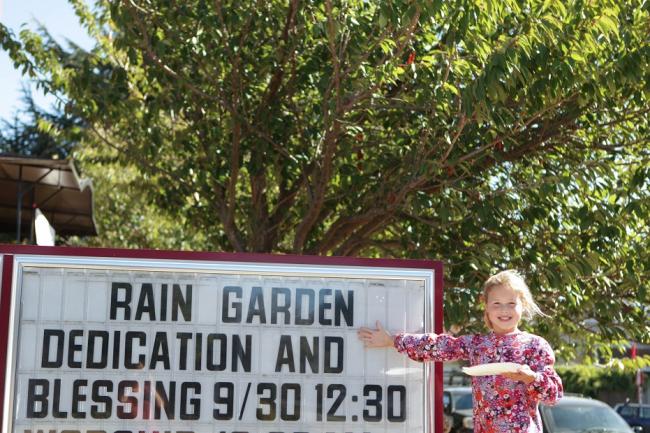Praying for precipitation to kick start new rain garden
Wed, 10/03/2012
By Elizabeth Wang
Though there wasn’t a cloud in sight, Trinity United Methodist Church celebrated the installation of its new rain garden, the largest, non-residential one of its kind, on Sept. 30.
Armed with scissors, a group of children commenced the ribbon-cutting ceremony and the rain garden was officially opened after church pastor Rev. Kathleen Weber passed on a blessing.
“I’m not a visual person,” Weber said. “But really seeing it unveil itself is very exciting. We really wanted people to interact with it so it’s really fun to see the kids run through it and explore the garden.”
Through the RainWise program, Seattle has begun building rain gardens around the area to help retain, filter and infiltrate runoff stormwater that can be collected from roofs, roadways and even parking lots. The resulting efforts not only reduce pollution to viable water streams and prevent erosive water power, but can sustain a myriad of flowers and plants.
The church’s rain garden was designed by Back to Nature Design, LLC and includes 5,000 square feet of roof coverage to serve the native, food-producing plants and trees planted in the garden. Though the original plan hoped to include as much as 15,000 square feet of coverage, the City had to scale back the designs as it hasn’t yet done a project of this size before. The process would then have taken much longer than the church had anticipated.
“We had visions for a larger project,” Weber said. “That would certainly be a great hope that if this is successful that we could do the full project we had initially envisioned.”
Brooke Sullivan, who was part of the design team, drew up the plans for the rain garden. The multiple-garden arrangement is set up to relate back to the natural elements: Earth, air, fire and water.
“The Earth garden is intended to be very green and evergreen,” Sullivan said. “It’s kind of shady and kind of quiet. The fire garden is supposed to be very active. We put five fruit trees in and almost everything is edible. The intent is really to get the water off the roof, so the goal is to really infiltrate that water.”
Sticking to their commitment to environmental sustainability, the church and the designers avoided as much construction as possible that may harm the surrounding soil. To reduce the possibility of toxin and glue leakage, they chose to use PVC pipes only where necessary. By staying away from the use of chemicals, they were also able to save a colony of ground-nesting bees that now, Sullivan said, are thriving on the fauna.
“I think our project helped the city,” Sullivan said. “We pushed the limits on a lot of stuff because of their commitment to environmental sustainability; they didn’t want to install PVC pipes ... so we worked very hard with the City to try to find an alternative.”
Chris Hellstern, secretary for the Trinity Ministry Council, gave the first push of rain garden to the church. Working with a sustainable-architecture firm and having previously worked with Sullivan on the Bertschi School Living Science Building, the state’s greenest new building, Hellstern is familiar with environmental projects.
“We have a responsibility, those of us who care about the environment, to practice our values,” Hellstern said. “For us, this is one of the ways we can do it –- a reason to help out community, to be good stewards and be good neighbors and help educate the public.”
Now that the construction of the garden is done and it has passed city inspections, all everyone can really hope for now is a good amount of water.
“We’re looking forward to the new rain,” Hellstern said. “See if it works.”
Currently, residents of the Ballard, Windemere, Delridge and North Union Bay Combined Sewer Overflow basins are eligible to participate in the effort to collect roof-runoff water. Full rebates will be given out to those who choose to join in on the action and install a rain garden or cistern on their properties.
“I think always whenever you have a big project like this that it can just inspire people within and outside [the church,” Weber said. “I hope that it’s a reminder that we can do things that really do affect our environment or affect the way we live in the world together.”


